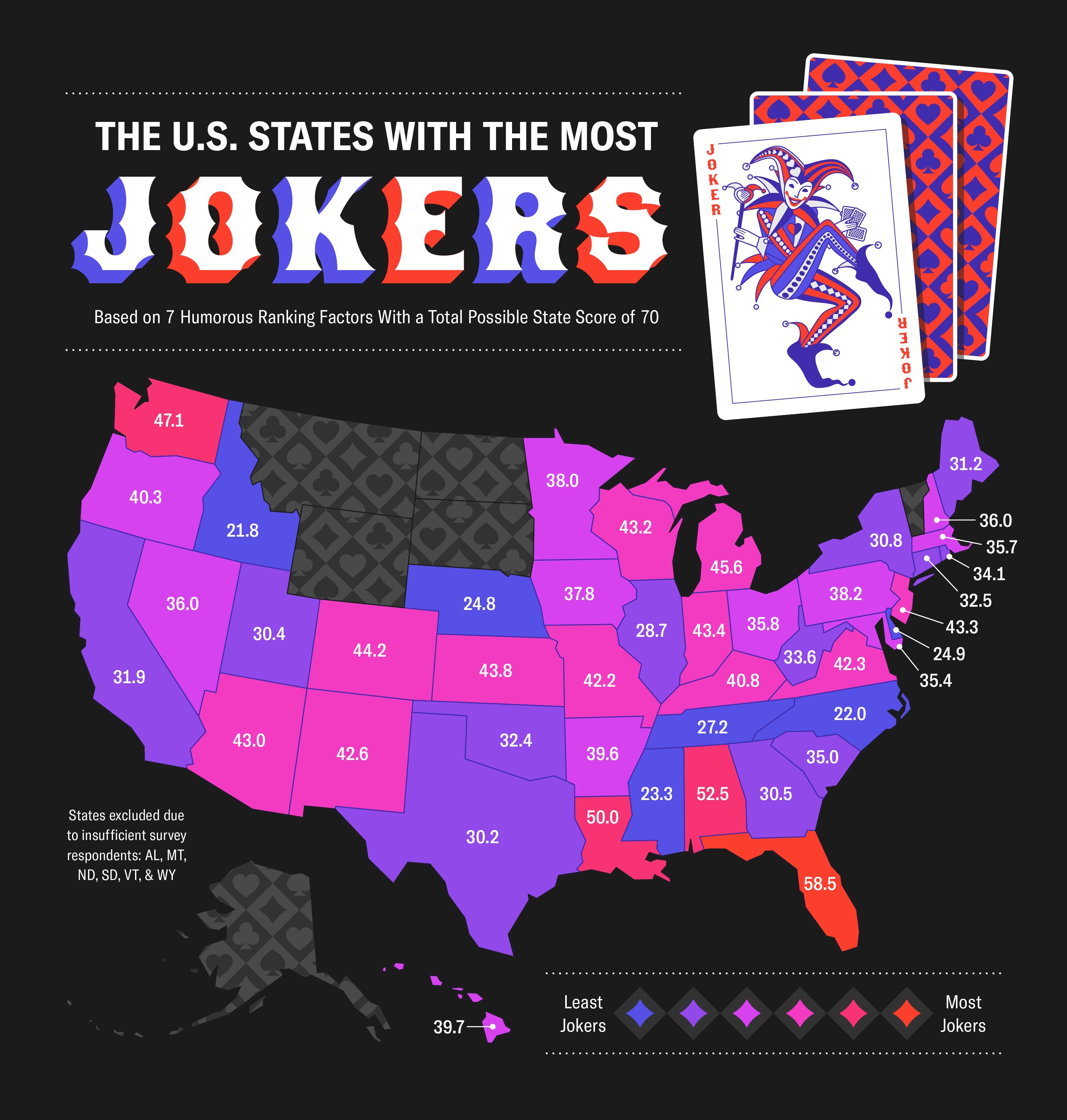- Table of contents
- The U.S. States with the Most Jokers
- Closing Thoughts
- Methodology
Calling all comedians (and appreciators of comedy)! BetMGM is on a mission to find the undisputed king (or queen) of laughs – the state with the most hilarious residents. We’re not just basing this on stereotypes – we’ve delved into the data to uncover which states crack the most jokes, have the strongest senses of humor, and laugh the most.
So, is your home state a laugh riot or more of a monotone mumble? Buckle up and get ready to find out!
The U.S. States with the Most Jokers

According to our survey, the Sunshine State reigns supreme in the comedy department. Florida snagged the top spot with a score of 58.5, proving that perhaps there really is something to that laid-back, beachy lifestyle that breeds humor. Following Florida, Alabama, Louisiana, Washington, and Michigan round out the top five jokester states.
But what exactly makes these states so funny? In Florida, it’s largely due to the 10 jokes the average resident cracks every day. They also find themselves laughing nearly 17 times in the average 24 hours.
Similarly, Alabamans average roughly seven jokes a day. They’re also strong consumers of comedy, ranking high in both comedy show attendance and the number of comedy podcasts they listen to. In Louisiana, half of the average person’s social media feeds are dominated by humorous content.
On the opposite end, Idaho ranks as the U.S. state with the fewest jokesters. Comedic content accounts for roughly one-third of their feeds and the average Idaho resident rates their sense of humor a six out of 10, compared to the national average of seven. Other states that rank low include North Carolina, where residents tell just shy of four jokes a day, and Mississippi, where residents can count on two hands the number of times they laugh in a given day (eight).
Interestingly, the data shows a trend of younger generations telling more jokes. Gen Z reports telling the most jokes on average (eight jokes a day!), while Baby Boomers bring up the rear (averaging only three jokes a day). This could be due to a generational difference in what constitutes “telling a joke” or simply a reflection of how humor evolves over time.
It’s also worth noting that social media engagement with comedy is highest among Gen Z (50%), followed by Millennials (42%). Women, on average, watch more comedic movies and TV shows than men, and they also engage with more comedic social media than men.
Looking at comedy consumption habits, Millennials and Gen Z watch the most comedies overall, with about 40% of what they watch falling into the comedy genre. Podcasts are another battleground for humor, with Millennials again claiming the top spot for listening (31% listen regularly). Interestingly, more than twice as many men listen to comedy podcasts regularly (22%) than women (10%).
Closing Thoughts
So, who takes the cake as America’s funniest state? Florida, with its laid-back charm and infectious laughter, takes the top spot. But remember, humor is subjective, and every state has its own unique brand of comedy. Whether you’re a fan of witty banter, slapstick humor, or something in between, there’s a laugh waiting for you somewhere in the United States.
BetMGM understands that laughter is a powerful force, just like the thrill of a good card, slot, or casino game. All require a mix of strategy, timing, and a little bit of luck. BetMGM offers a variety of online casino games and promotions to keep the fun going. Ready to test your luck and your sense of humor? Visit BetMGM today and join the fun!
Methodology
To know which states have the most and least jokers, we surveyed Americans from every state with questions related to joking, sense of humor, and comedy entertainment consumption. We then evenly weighted each question to give every state analyzed a score out of 70 (1 being not at all funny and 70 being everyone around you is constantly laughing) based on their results. You can see the list from most to least jokers to the left. It’s worth noting that due to their lower populations, we did not receive enough responses from Alaska, Montana, North Dakota, South Dakota, Vermont, and Wyoming to include.














